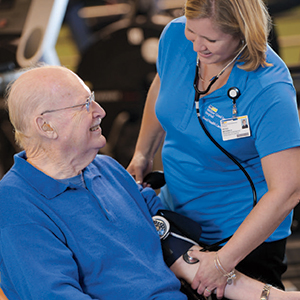Find care now
If you are experiencing a medical emergency, please call 911 or seek care at an emergency room.

When an individual has experienced a cardiac event, it is often life-changing. Recovering from such an episode can be a daunting process that impacts many aspects of a person’s life. Yet, many patients don’t get the help they need to successfully move forward with recovery. “Once a patient is discharged from the hospital after a heart incident, it should set in motion the next phase of treatment—participation in a structured cardiac rehabilitation program,” says Jelles Fonda, MD, a cardiologist at MedStar Good Samaritan Hospital.
The hospital’s cardiac patients are encouraged to get the support they need by enrolling in a program that includes education, exercise, nutritional counseling, stress management and more. “Cardiac rehabilitation is a proven method for recovery, one that has been shown to make patients stronger, healthier and more confident,” Dr. Fonda notes. Bill Shaprow, an 80-year-old patient of Dr. Fonda’s, is a big fan of the cardiac rehab program at MedStar Good Samaritan. “Going through rehab gives you a better outlook on life,” Shaprow says. “The program helps you strengthen your heart while improving your overall health and well-being.”

Phase I of cardiac rehabilitation begins for each patient right in the hospital following a cardiac event. After discharge, the cardiac rehab services offered at MedStar Good Samaritan are provided through the Good Health Center, where a team of expert cardiologists, nurses, health educators, and health fitness specialists partner with patients, their families and their primary care doctors to develop individualized rehab programs. The program is certified by the American Association of Cardiovascular and Pulmonary Rehabilitation. The Phase II program, designed specifically for those recovering from a heart attack, coronary artery bypass graft, angioplasty or coronary stenting, heart valve replacement or repair, a left ventricular assist device (LVAD) implant, a heart or heart-lung transplant or heart failure, involves a carefully monitored combination of exercise therapy and education.
“The program is designed to help patients feel better faster, get stronger, reduce stress, manage their blood pressure and increase their self-confidence,” explains Nicole McDonald, program coordinator at the Good Health Center. “Patients enrolled in the program attend structured sessions for one hour three times a week for 12 weeks. During these sessions, they exercise and they learn. We cover topics ranging from how to eat heart healthy to ways to make positive behavioral changes. Patients are evaluated at the start of the program, 30 days, 60 days and at discharge, and their physicians are kept informed of their progress.“ Shaprow has been through the Phase II program twice—after a coronary stenting when he was 75, and last year following a heart attack and treatment with another stent.

“When you get there, they take your blood pressure, put a monitoring unit on you, which is connected to your chest, and give you a variety of cardiovascular exercises to do. In the beginning, you might do 10 minutes each on a stationary bike, a treadmill and a hand bike,” he explains. “Then during the next visit, the time you spend doing each exercise slowly increases. It’s not vigorous—you’re closely watched and the staff is very caring.” Shaprow, an outgoing man who speaks fondly of his past as a former Porsche race car driver—he even named his daughter Portia—also appreciates the camaraderie at the Good Health Center. “Everyone is there for the same reason and that breaks down barriers. You encourage and check up on each other,” he adds. He credits the program with helping him maintain a positive attitude despite the fact that he also is dealing with several other health issues, including degenerative disc disease, which makes it difficult for him to walk without a cane. At the hospital, he is treated by a multidisciplinary team that includes Maneesh Sharma, MD, a pain management specialist, and Mohammad Khan, MD, his primary care physician, plus Dr. Fonda.
“All of my doctors are with MedStar Good Samaritan Hospital. I’m over there all the time,” he notes. Since graduating from the Phase II cardiac rehab program, Shaprow has enrolled in Phase III, a less structured and more independent exercise program that patients follow on their own. “I work on my lower extremities…my legs and hips. I can really feel the difference.” While there, the Good Health Center staff continues to assist him with periodic exercise program updates and modifications. “Nearly everyone can benefit from cardiac rehab,” adds Dr. Fonda. “Unfortunately, it’s one of the most underutilized rehabilitation services in this country. A lot of patients just don’t want to take the time to do it, or think it won’t help. But here at MedStar Good Samaritan, we urge our patients to enroll. For improving quality of life, it’s better than any pill or procedure.” The Phase III program at the Good Health Center also is available for noncardiac clients who have a chronic condition for which exercise has been proven to be beneficial, such as arthritis, diabetes, high blood pressure and obesity. The Good Health Center accepts patients referred from any healthcare facility, not just MedStar Good Samaritan.
This article appeared in the winter 2017 issue of Good Health. Read more articles from this issue.
Location Information
MedStar Good Samaritan Hospital
Cardiac Rehabilitation Program
5601 Loch Raven Blvd.
Good Health Center, 2nd Floor, O'Neill Building
Baltimore, MD 21239
Call 443-444-3874 to register, by appointment only.
Three hourly sessions per week, Mondays, Wednesdays and Fridays
9 a.m. to 10 a.m. or 11 a.m. to noon














